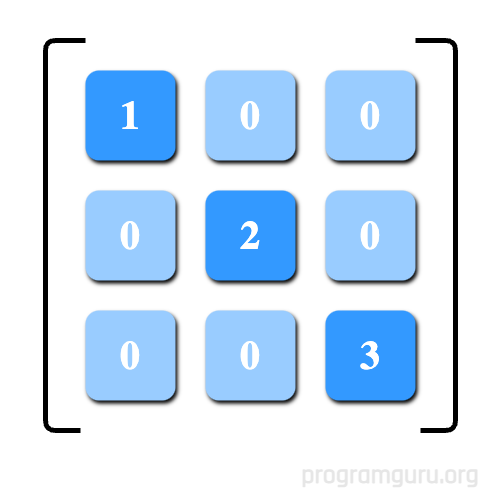How to Create Diagonal Matrices in R - Step by Step Examples
How to Create Diagonal Matrices in R ?
Answer
To create diagonal matrices in R, you can use the diag() function. This function can be used in various ways to create matrices with specified diagonal values, either from a single vector or by specifying dimensions and a value.

✐ Examples
1 Creating a Diagonal Matrix from a Vector
In this example,
- We start by creating a vector named
veccontaining the valuesc(1, 2, 3, 4). - We then use the
diag()function withvecas the argument. This function takes the values invecand places them on the diagonal of a new matrix, with all off-diagonal elements set to zero. - The resulting matrix is stored in a variable named
diagonal_matrix. - Finally, we print the value of
diagonal_matrixto standard output to see the resulting diagonal matrix.
R Program
vec <- c(1, 2, 3, 4)
diagonal_matrix <- diag(vec)
print(diagonal_matrix)Output
[,1] [,2] [,3] [,4] [1,] 1 0 0 0 [2,] 0 2 0 0 [3,] 0 0 3 0 [4,] 0 0 0 4
2 Creating an Identity Matrix
In this example,
- We use the
diag()function with a single integer argument4. This integer specifies the dimensions of the resulting square identity matrix. - The
diag()function creates a 4x4 identity matrix, with ones on the diagonal and zeros elsewhere. - The resulting matrix is stored in a variable named
identity_matrix. - Finally, we print the value of
identity_matrixto standard output to see the identity matrix.
R Program
identity_matrix <- diag(4)
print(identity_matrix)Output
[,1] [,2] [,3] [,4] [1,] 1 0 0 0 [2,] 0 1 0 0 [3,] 0 0 1 0 [4,] 0 0 0 1
3 Creating a Diagonal Matrix with Specified Dimensions and Value
In this example,
- We use the
diag()function with two arguments: a scalar value5and an integer3. The scalar value specifies the value to be placed on the diagonal, and the integer specifies the dimensions of the resulting square matrix. - The
diag()function creates a 3x3 matrix with the value5on the diagonal and zeros elsewhere. - The resulting matrix is stored in a variable named
custom_diagonal_matrix. - Finally, we print the value of
custom_diagonal_matrixto standard output to see the resulting matrix.
R Program
custom_diagonal_matrix <- diag(5, 3)
print(custom_diagonal_matrix)Output
[,1] [,2] [,3] [1,] 5 0 0 [2,] 0 5 0 [3,] 0 0 5
Summary
In this tutorial, we learned How to Create Diagonal Matrices in R language with well detailed examples.
More R Matrices Tutorials
- How to Create a Matrix in R ?
- How to Combine Matrices by Columns in R ?
- How to Combine Matrices by Rows in R ?
- How to Create Diagonal Matrices in R ?
- How to Access Matrix Elements using Indexing and Slicing in R ?
- How to get Matrix Size in R ?
- How to get Number of Rows in Matrix in R ?
- How to get Number of Columns in Matrix in R ?
- How to do Matrix Addition in R ?
- How to do Matrix Subtraction in R ?
- How to do Matrix Multiplication in R ?
- How to do Scalar Multiplication on a Matrix in R ?
- How to do Scalar Division on a Matrix in R ?
- How to do Element-Wise Operations in a Matrix in R ?
- How to Assign Row and Column Names in a Matrix in R ?
- How to get Row Names in a Matrix in R ?
- How to get Column Names in a Matrix in R ?
- How to find Transpose of a Matrix in R ?
- How to Extract the Diagonal of a Matrix in R ?
- How to find Determinant of a Matrix in R ?
- How to find Inverse of a Matrix in R ?
- How to find Rank of a Matrix in R ?
- How to Find Eigenvalues and Eigenvectors of a Matrix in R ?
- How to Perform Singular Value Decomposition (SVD) in R ?
- How to Perform QR Decomposition in R ?
- How to Perform Cholesky Decomposition in R ?
- How to Reshape Matrices in R ?
- How to Convert Data Frames to Matrices in R ?
- How to Create Identity Matrix in R ?
- How to Create Zero Matrix in R ?
- How to Create Ones Matrix in R ?
- How to Generate Random Matrices in R ?
- How to Calculate Row and Column Sums in R ?
- How to Calculate Row and Column Means in R ?
- How to Find Row and Column Max/Min in R ?
- How to Perform Element-Wise Comparisons in R ?